- Home
- Encyclopedia
- Five Wyoming Oil Fields and The Transformation ...
Five Wyoming Oil Fields and the Transformation of an Economy
The story of Wyoming in the 20th century is the story of a shift from a ranching and farming economy to an industrial one, dominated by the extraction of oil, gas and coal.
Part of that story is contained in the history of five of the state’s major oil fields—the Lance Creek, Elk Basin, Oregon Basin, Grass Creek and Big Muddy fields. The Lance Creek Field in Niobrara County was the most productive of the five by the end of 1956, followed by the Elk Basin and Oregon Basin fields in Park County; Grass Creek in Hot Springs County; and the Big Muddy Field in Converse County. All were early large producers, sparking the development of roads, pipelines and refineries as the market for oil grew.
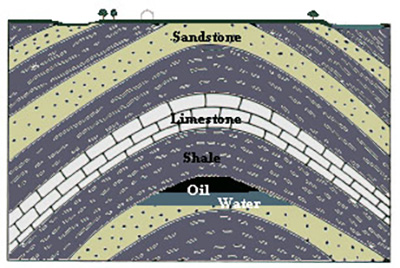
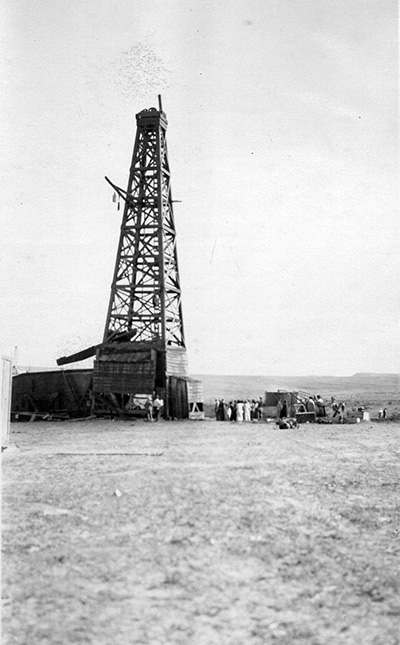
|
By the early 1920s, the Salt Creek Oil Field in Natrona County was one of the most productive in the nation. But the business was growing fast across the state; these other fields, less well known now, contributed substantially to Wyoming’s wealth and to the oil business’s drilling and production knowhow—and spurred the birth and growth of towns in far-flung parts of the state.
Their producers all faced similar problems: dry holes, claim jumpers, how to house workers and how to deal with them when they became stir-crazy living in isolated camps without female company. Later, the few women who braved life with their husbands in the earliest camps might, for months on end, have only one other woman to talk to. Worker safety was also a constant problem, with fires and collapsing derricks the most common hazards. And because it was a long way to railways and refineries, hauling equipment to the field and moving the oil out were often extremely difficult.
Oil was used mostly as a lubricant before 1850 when kerosene began to take over the market for lamp oil, replacing costly whale oil. In 1895 a refinery was built near Casper, but it was the era of the automobile with the resulting demand for gasoline that put oil production in Wyoming into high gear. From 1900 on, an increasing number of Wyoming residents purchased cars, and by 1917, the state had five refineries.
Wyoming's early oil fields were almost always discovered by amateur or professional geologists who noticed the presence of oil seeps or, more often as time went on, anticlines—arched strata that trap oil underground under the crest. As producers and geologists accumulated experience with each discovery, investors became more willing to risk money on drilling, even after a succession of dry holes or shallow wells in a given location. Although the expertise of geologists was not widely accepted at first, by 1915 it was generally known that oil would probably be found where the experts predicted.
For more than 100 years, that persistence plus the lure of big money from ever-increasing demand has pumped a combined total of more than 1.4 billion barrels from the five, although records are sketchy between 1956 and 1978. As of 2013, all these fields were still producing, with Elk Basin in the lead, followed by Oregon Basin, Grass Creek, Lance Creek and Big Muddy. Salt Creek remains the largest, producing 4.5 million barrels in 2013 alone.
Park County: Oregon Basin and Elk Basin
C. A. Fisher was the first geologist to investigate and map a portion of the Oregon Basin, 14 miles southeast of Cody, Wyo. A 1907 bulletin emphasized the likely oil and gas producing properties of the area. In 1908, another geologist, Thomas Harrison, then working for the U.S. Government Land Office in Cheyenne, Wyo., visited the basin—not looking for oil, but inspecting the coal mines and an irrigation project. Harrison compared the geology of the Oregon Basin to that of other Wyoming fields, and moved to take advantage of what he decided was a good opportunity.
In September 1912, Harrison became vice president of Enalpac, a company that included two experienced drillers from the Salt Creek Field. They had already begun drilling in the Oregon Basin that summer, with the first significant well completed on Aug. 24, 1912. Drilling reached 1,322 feet when it penetrated a natural gas-bearing strata and was halted. The enormous pressure from the gas blew dirt and rocks 50 feet into the air, endangering the crew.
A more serious episode occurred the following winter. In early September 1912, Harrison had drilled a second deep well, the Pauline. But it caved in, filled with water, and tools were lost down the hole. In January and February of 1913, at temperatures of 16 degrees below zero and with freezing water spraying on them, Harrison's crew attempted to partially fill in the caved-in, watery hole. Their goal was to pack the hole with rocks and a concrete casing until this artificial bottom reached a level that had previously shown an oil-bearing sand. They finally succeeded in filling the hole to the desired level, but could not pump out any oil. Harrison had nothing to show for all that work.
Another 10 years of off-and-on drilling followed. Enalpac and the Oregon Basin Oil and Gas Company had discovered oil in small quantities, but with additional high-pressure gas wells continuing to cause problems. Exploration, it was becoming clear, was not viable for small companies.
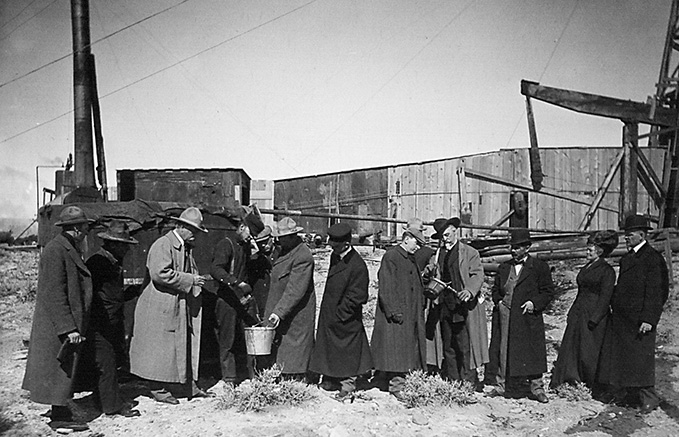
The Ohio Oil Company, which later became Marathon, began drilling in fall 1924 under the able supervision of John "Jack" McFadyen. The Ohio made the first major oil strike in the Oregon Basin on Feb. 1, 1927. The well produced 800 barrels per day. By 1947, the major producers in the field were, in addition to the Ohio, the Texas Company (Texaco), Husky Refining, Pacific Western Oil Corporation and the interests of Casper businessman Fred Goodstein.
The Oregon Basin's cumulative production through 1956 was 76.6 million barrels, a figure that includes the West Oregon Basin Field, discovered in May 1955.
The Elk Basin laps across the border between Carbon County, Montana and northeastern Park County, Wyoming, 20 miles north of Powell. Farmer and geologist George Ketchum, who had a small farm at Cowley, Wyo., is generally credited with first recognizing the Elk Basin as a likely source of oil. Ketchum accompanied C. A. Fisher through Elk Basin in 1906; possibly Fisher was on the same expedition that took him through the Oregon Basin. Eventually, the Utah-Wyoming Oil Company rented a rig for drilling, and a local company, Grub Stake Oil, was organized to finance a well.
In addition, however, another group of Greybull and Basin men had taken out a claim in the same area.
In a fight over drilling rights, there was a confrontation in the field when the Grub Stake men turned back another outfit at gunpoint.
On Oct. 8, 1915, nine years after Ketchum and Fisher first investigated Elk Basin, the Midwest Refining Company, by then well established in the Natrona County fields, drilled the discovery well—the first successful well—in Elk Basin, which produced between 50 and 150 barrels per day.
The Midwest Company was soon joined by Ohio, and eventually the Continental Oil Company as well. As in the Oregon Basin explorations, the small companies, such as Grub Stake, lost out to the larger ones, because drilling was expensive and at least a few dry holes were inevitable. After drilling one well, the Grub Stake men were forced to quit.
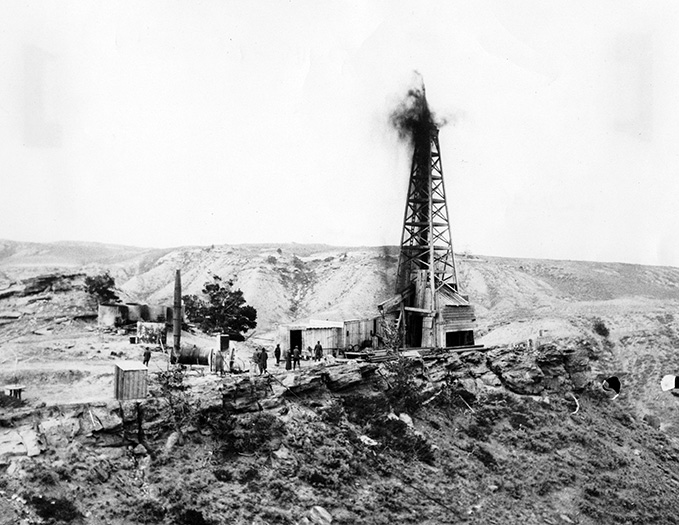
By 1916, both the Midwest and Ohio companies had built camps for their workers in Elk Basin. This settlement became a small town with streets and sidewalks, a hotel, community hall, hospital, gas pump, post office and a barber shop. In winter, Anna Haney, whose husband, Oscar, worked in the field, battled foot-high snowdrifts blown into her tin and tarpaper house. In summer, the dust was so thick and the wind blew so hard that food had to be eaten quickly before it got too gritty.
School was conducted in two buildings, one for grades one to six, and the other for grades seven to eight, serving 80 students at its peak. High school students attended classes in Powell, boarding there because roads between Powell and Elk Basin were bad.
The population of Elk Basin peaked at between 800 and 1,000 sometime before the early 1940s when the town had to be moved to Polecat Bench, a few miles south. Poisonous hydrogen sulfide gas, escaping from deeper wells, was endangering the health of the workers and their families. Housing at Polecat Bench was more modern, and roads had improved, siphoning residents away to Powell. In 1955, the town was disbanded along with the company camps, and some residents purchased their houses in Polecat Bench and moved them to Powell.
Elk Basin and the South Elk Basin Field, discovered in June 1945, together produced a cumulative total of 92.8 million barrels by the end of 1956.
Hot Springs County: Grass Creek Field
The first well in the Grass Creek Field, 40 miles northwest of Thermopolis, Wyo., in the foothills of the Absaroka Mountains, seems to have been drilled in 1907 or 1908; sources differ. But all agree it was a chaotic time in the business—and the successful companies were the ones that figured out how to take advantage of the situation. Operating on the principle that where small discoveries had been made, larger ones were likely to follow, the Ohio Company drilled a producing well in 1914, ending the year with 11 producing wells in the field. This proved that it could be simpler and less risky to invest in properties that others had already shown to be productive.
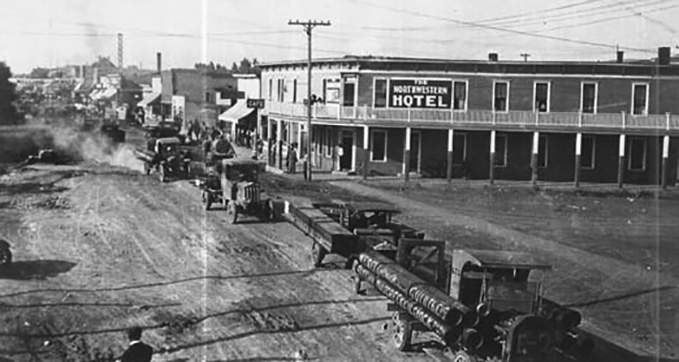
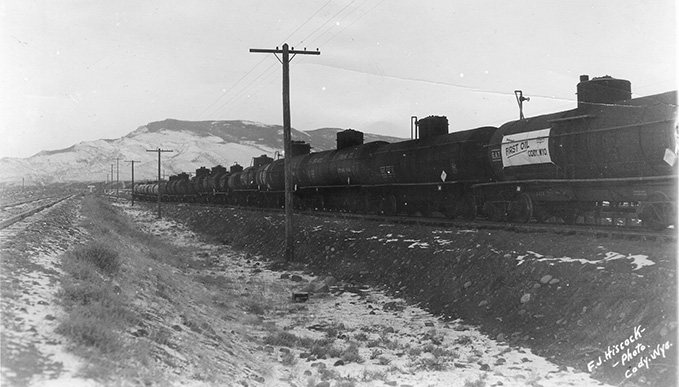
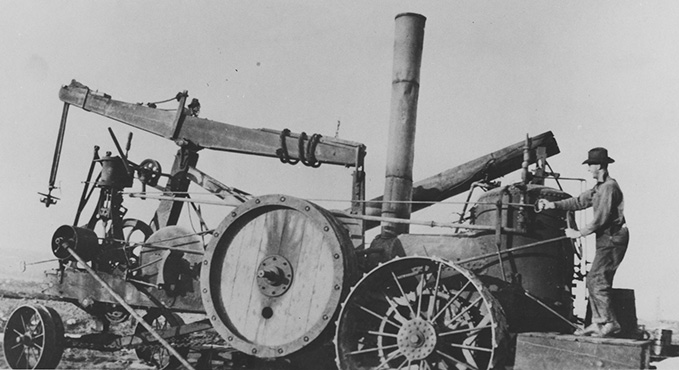
Difficulties were numerous, however. Claims overlapped because of imprecise surveys. Competing parties spied on each other, climbing ridges and watching through binoculars. Once a claim had been staked, rivals came in at night, moved the stakes, and began the process of legitimizing their claims by putting up a building.
Before the Mineral Leasing Act of 1920, land could be legally claimed by persons paying $2.50 per acre and improving the parcel with a building or other improvements. This entitled them to ownership of all oil, coal, and other mineral commodities discovered on that land. After passage of the Act, producers of oil, coal, natural gas and phosphates paid up-front to lease federal land, and then paid the government a one eighth royalty on the mineral revenues from that land. So claim jumpers could no longer simply move in, displace stakes and put up a building.
In addition to the problem of claim jumpers before 1920, the Grass Creek Field was remote. Drill pipe and other equipment was freighted in by mule teams from a distant railroad siding, and transportation costs often totaled more than the $3 per foot it cost to drill.
The early Grass Creek oil camp, established in about 1914 by the Ohio, soon became a town. Along with bunkhouses and a separate cookhouse for the workers, Grass Creek had a post office, hospital, theater, saloon, dance hall and pool hall plus a store, the Wyoming Trading Company. There was also a women's Community Club, Girl and Boy scouts, 4-H Clubs and a Sunday school and church services. The town grew to 500 before the oil camp began to be phased out in the early 1960s.
A murder at the Grass Creek Field made national news. Two oil field workers, Albert Lampitt and Harry Foight, had been vying for the affections of Grace Lee, a housekeeper and cook. When a dynamite-nitroglycerin bomb exploded directly under Foight's bunk at 2:00 a.m. on May 7, 1921, Foight and his roommate, Worely Seaton, were killed. Three other men were severely but not critically injured. Circumstantial evidence pointed to Lampitt, who had purchased a fuse and caps, and had also sought information from the camp's expert on how to rig a dynamite-glycerine charge. In addition, the camp's explosives storehouse had been robbed. Lampitt was convicted and sentenced to life imprisonment, later commuted to 65 years. He was released after serving half his time.
In addition to the Ohio, companies active in the field were Midwest, later absorbed by Standard Oil; Mexico-Wyoming; Exxon; Atlantic Richfield and Amoco. Cumulative production reached 60.7 million barrels by the end of 1956.
Niobrara County: Lance Creek
In the Lance Creek Field, about 22 miles north of Lusk, Wyo., drillers drilled dry holes for five years before oil was finally discovered. It was a cattle ranching area until 1912, when a Dr. J. E. Hawthorne of Lusk tried without success to raise funds for drilling. The Lusk, Wyoming Oil Company incorporated on April 29, 1913, drilled down to 2,250 feet by August of that year but failed to find oil. A lack of money stopped further exploration by that company in June 1914.
Image
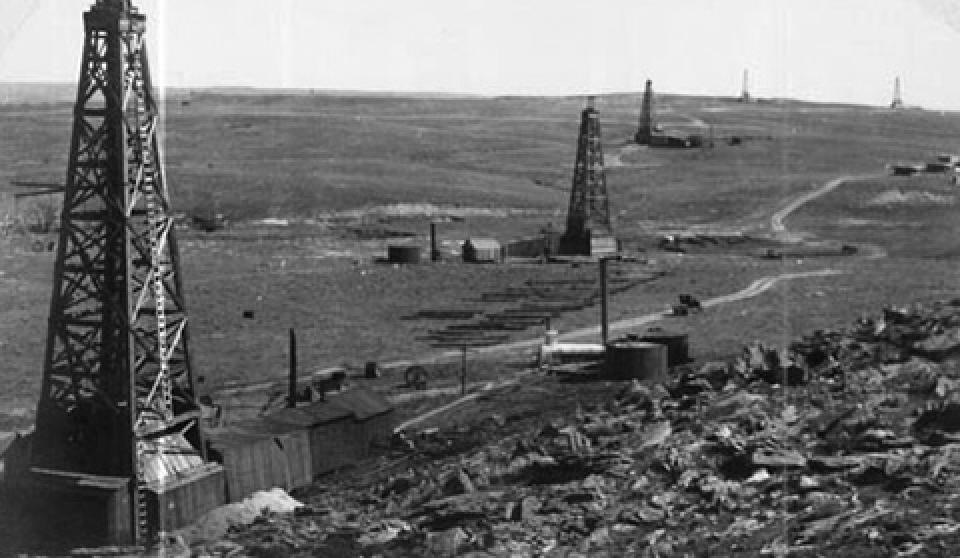
Next, four more companies or individuals drilled without success until the Ohio drilled on March 13, 1918. Eighty barrels flowed in the first 24 hours. Seven months later, on Oct. 6, 1918, the Ohio drilled deeper and this time the well flowed at 1,500 barrels in the first 24 hours. This was recorded as the discovery well.
Derricks sprouted everywhere in the instant boom. In four days, 555 tons of freight were hauled from Lusk. At the peak of oil operations in the field, the community of Lance Creek housed 1,500 people, served by cafes, barber shops, beauty parlors, mechanic shops, grocery stores, filling and service stations and many other businesses. Residents could play golf or tennis, shoot at the rifle range, go roller skating, see a movie, go bowling or play pool. Seven civic organizations also served the community, including Boy Scouts, Girl Scouts and a square dance club. By 1986, with the decline of field activity, the population of Lance Creek had dwindled to between 75 and 100; the 2010 census counted 43.
By the end of 1956, the cumulative production of the Lance Creek Field plus the East Lance Creek Field, discovered on Sept. 4, 1919, was 96.4 million barrels.
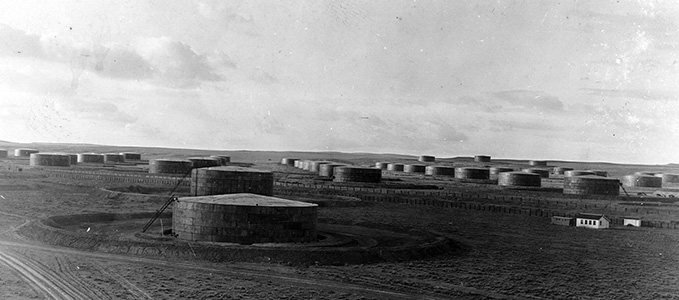
Converse County: Big Muddy
The Big Muddy Field is located between Casper and Glenrock, Wyo., on the south bank of the North Platte River about two and a half miles east of Glenrock. In 1913, under a directive from the U.S. Department of the Interior, geologist V. H. Barnett conducted a geological and land classification survey in the Big Muddy area. Barnett reported that oil would likely be found in the field, but only drilling could verify this.
The discovery well was drilled in 1916, probably by the Merritt Oil and Gas Company. Initial daily production was 26 barrels per day, and early on, within the first year or two, other wells averaged 35 barrels per day, with a few producing 300 to 400 barrels per day. The usual frenzied development ensued, characteristic of Wyoming's early oil fields after the first significant discovery. Claim jumpers were ready to move in, and McFadyen of the Ohio Company drilled only at night, during the day pretending to be constructing a pipeline camp. He also instructed his men not to talk about their work when they went to town.
Thirteen steam boilers were stolen from one company's stock. As at Oregon Basin, tools were lost down holes. Scotty Yost, a "tool-pusher," was lowered 50 feet down a hole 20 inches in diameter to recover a 15-inch drill. One small outfit, the Green Drilling Company, hit a well that flowed two to three hundred barrels in 15 minutes straight into the Platte River─because the company was unprepared either to store it or to pipe it.
Typical camp conditions prevailed, with cookhouses, bachelor bunkhouses and houses for married workers. In the Ohio camp, a Mrs. Fred E. Smith was for some months the only woman in camp except for a cook and a waitress. One summer day, Mrs. Smith looked out of her house to check on one of her babies, asleep in a playpen. A six-foot rattlesnake, also asleep, lay next to the baby. Mrs. Smith approached the pen, carefully lifted her daughter out and carried her inside.
Settlement proceeded along with development. Parkerton, the community, and the Chicago and Northwestern Railroad’s Parkerton station located at the Big Muddy Field, were named after an early driller, H. Leslie Parker, and sprang up about 1917. Businesses followed, and schools: From 1916 to 1920, three were established, including a high school and a grade school with a gymnasium. The population of Glenrock also mushroomed from 500 to 2,000 by 1918.
By 1923, the population of Parkerton had peaked at 2,500; also in that year, schools were consolidated with the Glenrock district. By 1935, Parkerton had largely been deserted and was occupied by pumpers, well tenders and field supervisors.
By the end of 1956, the cumulative production of Big Muddy was 37.6 million barrels.
Economic benefits for Wyoming
By 1987, Oregon Basin, Elk Basin and Grass Creek were still among the top 25 oil fields in Wyoming. Oregon Basin led the state in 1987 production with 9 million barrels, exceeding even the historic mega-producer, Salt Creek, for that year—ranked third below Hartzog Draw, an oil field about 35 miles southwest of Gillette, Wyo., off Highway 50. Although Salt Creek produced only 5 million barrels in 1987, it still led the list in cumulative production at the end of 1987, at 621.5 million barrels.
Image
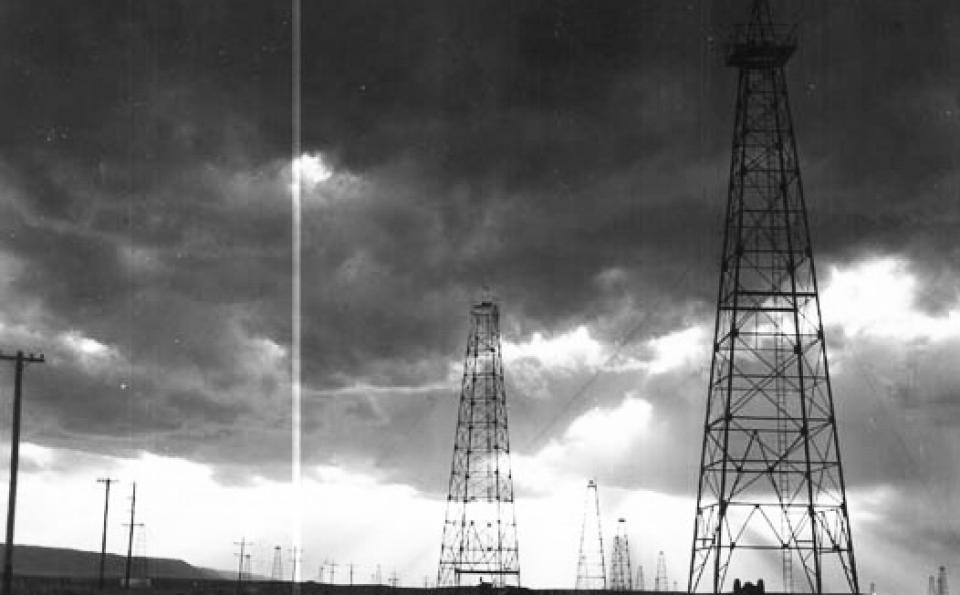
Figures from the Wyoming Department of Revenue from the beginning of the four decades from 1940 to 1970 show a steady increase in oil production and valuation for the state as a whole. In 1940, nearly 20.5 million barrels were produced; in 1970, 140.5 million. Valuation in 1940 was approximately $16.5 million; in 1970, $393.5 million.
Holders of oil and gas properties always paid taxes on the value of the properties, but the state did not significantly tax oil and gas revenues until 1969. Historian Samuel Western notes that in 1968, Gov. Stan Hathaway discovered that Wyoming had only $80 in the general fund. The general fund is the state's main bank account, from which state agencies are funded. Revenues to the fund come from taxes on cigarettes and liquor; sales and use taxes; and license and permit fees, among other sources. Hathaway's startling realization led to the creation of the one percent severance tax on oil, gas and coal, which the Legislature passed in 1969.
The tax was increased another two percentage points in 1973, and by then, the general fund had increased to $100 million. The Legislature then established a system whereby the severance tax revenues flow into the Permanent Mineral Trust Fund, which by law protects the capital—the corpus of the fund—allowing spending only of the interest and other revenues generated by the fund.
This increase in revenues from mineral extraction reflects the economic shifts in the relative values of the different sectors of Wyoming’s economy. In 1910, agriculture led the state, with assessed valuations on cattle and sheep at $32.9 million. Output of mines—this included oil and gas—was assessed at $5.2 million. By 1955, at least one sector of recreation had overtaken agriculture: Expenditures for hunting and fishing passed $23.4 million, more than the cash value of all agricultural crops produced statewide. By 1970, mineral valuations had far outstripped agriculture, with minerals at $470.1 million; sheep and cattle at $52.4 million. By 2008, the state’s gross domestic product figures show, mineral production stood at $13.9 billion, leisure and hospitality (forestry and fishing; arts, entertainment and recreation; and accommodation and food services) at $1.4 billion and agriculture at $380 million.
Enhanced oil recovery (EOR)—by the injection of gas, chemicals and steam into old oil fields—began in the late 1960s, and has been widely implemented in Wyoming. Chemical EOR has been done in the Oregon Basin, Elk Basin and Grass Creek fields, and water flooding to increase natural pressure in oil reservoirs has been done in the Lance Creek and Big Muddy fields.
Distributions from mineral revenues, not limited to oil, but also including natural gas, coal, trona, bentonite and other marketable minerals, have benefited every citizen in the state. Thus, however much we think of ourselves as the Cowboy State and cherish our clean air and wide, unspoiled vistas, the mineral extraction industry is the mainstay of Wyoming's economy.
Resources
Primary Sources
- Hernandez, Lollie. "Elk Basin town no longer exists but memories live," Powell Tribune, Aug. 16, 1979.
Secondary Sources
- Biggs, Paul and Ralph H. Espach. “Petroleum and Natural Gas Fields in Wyoming.” United States Department of the Interior, Bureau of Mines Bulletin 582. Washington, D.C.: GPO, 1960, 29-32, 92-99, 115-117, 149-154, 195-198.
- Brubaker, Elbridge Leroy. "The Early History of the Big Muddy Oil Field." Unpublished paper written for University of Wyoming's Field Summer Work Shop, Course 674-M, Resource Development in Oil and Gas. Mr. Ed Swanson, Instructor. July 9, 1962. Casper, Wyo.: Casper College Western History Center, 1962, 4, 9-16, 23-25.
- Cook, Jeannie, et. al. Buffalo Bill's Town in the Rockies: A Pictorial History of Cody, Wyoming. Virginia Beach, Va.: Donning Company Publishers, 1996, 109-110.
- DeBruin, Rodney. “Wyoming's Oil and Gas Industry in the 1980s: A Time of Change.” Public Information Circular No. 28. Laramie, Wyo.: Geological Survey of Wyoming, 1989, 6.
- Hancock, E.T. “The Lance Creek Oil and Gas Field: Niobrara County, Wyoming.” Contributions to Economic Geology, Part II. Bulletin 716-E, United States Geological Survey. Washington, D.C.: GPO, 1920, 91-93.
- Harmston, F.K., et al. A Study of the Resources, People and Economy of the Big Horn Basin, Wyoming, rev. ed. Division of Business and Economic Research, College of Commerce and Industry, University of Wyoming. Laramie, Wyo.: Wyoming Natural Resource Board, 1959, 38.
- Jones, Nick. Personal email to the author, July 22, 2014.
- Larson, T. A. History of Wyoming. 2d. ed., rev. Lincoln, Neb.: University of Nebraska Press, 1978, 533.
- Lindsay, Charles. The Big Horn Basin. University Studies of the University of Nebraska, vols. 28-29, 1928-1929. Lincoln, Neb.: University of Nebraska, 1932, 250-252.
- Mackey, Mike. Black Gold: Patterns in the Development of Wyoming's Oil Industry. Powell, Wyo.: Western History Publications, 1997, 33-44.
- Mackey, Mike. Wyoming in the Twentieth Century: Topics in the History of the Cowboy State. Sheridan, Wyo.: Western History Publications, 2011, 78-81.
- Milek, Dorothy B. Hot Springs: A Wyoming County History. Basin, Wyo.: Saddlebag Books, 1986, 197, 261, 268, 270.
- Niobrara Historical Society. "Niobrara Historical Brevity," July 1, 1986. Accessed June 6, 2014, at http://www.niobraracountylibrary.or/history/index.php?id=36.
- Rea, Tom. "Boom, Bust and After: Life in the Salt Creek Oil Field." Accessed June 6, 2014, at /essays/boom-bust-and-after-life-salt-creek-oil-field.
- Roberts, Phil. "The Oil Business in Wyoming." Accessed June 6, 2014, at /encyclopedia/oil-business-wyoming.
- Spence, Hartzell. Portrait in Oil: How the Ohio Oil Company Grew to Become Marathon. New York: McGraw-Hill, 1962, 50, 72-76, 95-100, 102-104, 189.
- Wasden, David J. From Beaver to Oil: A Century in the Development of Wyoming's Big Horn Basin. Cheyenne, Wyo.: Pioneer Printing and Stationery Co., 1973, 264-267.
- Western, Samuel. "The Mineral Leasing Act of 1920: The Law that Changed Wyoming's Economic Destiny." Accessed July 20, 2014, at /essays/mineral-leasing-act-1920.
- Western, Samuel. Pushed Off the Mountain, Sold Down the River: Wyoming's Search for Its Soul. Moose, Wyo.: Homestead Publishing, 2002, 64-66.
- Wyoming Department of Revenue. Annual Report 1939-40, 67. Accessed June 6, 2014, at https://sites.google.com/a/wyo.gov/wy-dor/dor-annual-reports.
- _______________. Annual Report 1969-70, 75. Accessed June 6, 2014, at https://sites.google.com/a/wyo.gov/wy-dor/dor-annual-reports.
- Wyoming Oil and Gas Conservation Commission. Accessed July 9, 2014, at http://wogcc.state.wy.us/.
- Wyoming State Board of Equalization. Twenty-Sixth Biennial Report of the State Board of Equalization for the State of Wyoming, 1969-70, 75, 84.
- Wyoming State Tax Commission. First Biennial Report of the Commissioner of Taxation, 1909-1910, 30, 31, 34.
Illustrations
- The photos of trucks leaving Lusk, derricks near Lusk and the Big Muddy Oil Field are from the Slug Sides and Terra Brown collections at the Niobrara County Library in Lusk. Used with permission and thanks.
- The 1928 photo of the tank cars near Cody is courtesy of the Park County Archives. Used with permission and thanks.
- The rest of the photos are from the American Heritage Center at the University of Wyoming, also used with permission and thanks. The 1917 photo of the gusher coming in at Elk Basin is from the AHC’s Kalstad Collection. The photo of Buffalo Bill Cody and others on the Shoshone anticline is from the George T. Beck Collection.
- The photo of the Star Machine is from the F.E. Smith Collection at the AHC. Star Machines, reports Everett DeWitt, oilfield historian for Anadarko at the Salt Creek Field in Natrona County, were initially pulled from place to place by a team of horses and later by a McCormick tractor. The machines were steam powered with a boiler that was pulled along on another wagon. Finding fuel for the boiler, DeWitt notes, could be tricky in parts of Wyoming where there were few trees and no coal.
